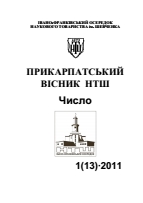NUMERICAL EVALUATION OF CORROSION CURRENT DENSITY ON INTERNAL SURFACE OF PIPE WELDS OF 12Х1МФ AND Х18Н10Т STEELS
Keywords:
welded dissimilar pipes, low-alloyed pearlitic steel, stainless austenitic steel, welded joints, corrosion current density, mechano- chemical and corrosive damages, numeric-analytical model.Abstract
Local mechanochemical and corrosive damages of heat-and-power engineering pipes essentially influence on its exploitation time and remaining life in exploitation conditions. The most important is to have possibility to predict the time of destruction of such objects. To realise that possibility it is necessary to estimate analytically the parameters change of investigated materials. In this work it is proposed the analytical correlations to determine corrosion current density from inside surface of welded dissimilar pipes.
They were obtained with help of polarities equilibrium method. These correlations were used for construction of relations of basis parameter: corrosion current density on internal surface of pipe welded joints of 12Х1МФ–Х18Н10Т steels. This model were realized on the base of experimental research which were conducted on the specimens made of real objects. It is necessary to note that for the investigation it was taken objects with different time of exploitation: material in delivery conditions and with exploitation time about 200000 hovers. In this work the distribution of corrosion current density in each of components of pipe welded joint 12Х1МФ–Х18Н10Т was analysed, namely, pipe made of 12Х1МФ (low-alloyed pearlitic steel) steel, welded zone between the pipes (it was taken different widths of welded zone within mathematical research), pipe made of Х18Н10Т steel (stainless austenitic steel). It was made the comparative analysis of characteristics of material as in delivery conditions so as exploited. It was formed the conclusions based on experimental research and also numeric-analytical model. With help of proposed numeric-analytical model we can have unobvious dependences of investigation objects behaviour on composition of environment, investigated materials in the system, and exploitation time of the object, as it is hard to get within straight analysis of experimental data. Obtained results can be used in future to investigate the kinetics of local corrosive damages growth in such objects.
References
2. Иоссель Ю.Я. Математические методы расчета электрохимической коррозии и защиты металлов. Справ / Ю.Я.Иоссель, Г.Э.Кленов. – М.: Металлургия, 1984. – 272 с.
3. Колодій Б.І. Метод еквівалентного електрода для визначення електрохімічних струмів у корозійній виразці / Б.І.Колодій, І.М.Дмитрах, О.Л.Білий // Фіз.-хім. механіка матеріалів. – 2002. – No 5. – С. 27-31.


